A High-Resolution Machine Vision System Using Computational Imaging Based on Multiple Image Capture During Object Transport
Abstract
1. Introduction
2. Essentials of Fourier Ptychography
3. Workflow of the Proposed Machine Vision System
3.1. Image Capture
3.2. ROI Extraction
3.3. FP Reconstruction Algorithm
4. Simulation Setup and Results
5. Object Transport Speed and Camera Exposure Time
6. Summary and Conclusions
Author Contributions
Funding
Data Availability Statement
Conflicts of Interest
References
- Davies, E.R. Machine Vision: Theory, Algorithms, Practicalities; Morgan Kaufmann: San Francisco, CA, USA, 2004. [Google Scholar]
- Ren, Z.; Fang, F.; Yan, N.; Wu, Y. State of the Art in Defect Detection Based on Machine Vision. Int. J. Precis. Eng. Manuf.-Green. Technol. 2022, 9, 661–691. [Google Scholar] [CrossRef]
- Golnabi, H.; Asadpour, A. Design and Application of Industrial Machine Vision Systems. Robotics Comput.-Integr. Manuf. 2007, 23, 630–637. [Google Scholar] [CrossRef]
- Zhang, M.; Chauhan, V.; Zhou, M. A Machine Vision Based Smart Conveyor System. In Thirteenth International Conference on Machine Vision; SPIE: Rome, Italy, 2021; Volume 11605, pp. 84–92. [Google Scholar] [CrossRef]
- Arsalan, M.; Aziz, A. Low-Cost Machine Vision System for Dimension Measurement of Fast Moving Conveyor Products. In Proceedings of the International Conference on Open Source Systems & Technologies (ICOSST 2012), Lahore, Pakistan, 20–22 December 2012; pp. 22–27. [Google Scholar] [CrossRef]
- Lohmann, A.W. Space–Bandwidth Product of Optical Signals and Systems. J. Opt. Soc. Am. A 1996, 13, 470–473. [Google Scholar] [CrossRef]
- Neifeld, M.A. Information, Resolution, and Space–Bandwidth Product. Opt. Lett. 1998, 23, 1477–1479. [Google Scholar] [CrossRef]
- Park, J.; Brady, D.J.; Zheng, G. Review of Bio-Optical Imaging Systems with a High Space-Bandwidth Product. Adv. Photonics 2021, 3, 044001. [Google Scholar] [CrossRef] [PubMed]
- Mait, J.N.; Euliss, G.W.; Athale, R.A. Computational Imaging. Adv. Opt. Photon. 2018, 10, 409–483. [Google Scholar] [CrossRef]
- Cossairt, O.S.; Miau, D.; Nayar, S.K. Gigapixel Computational Imaging. In 2011 IEEE International Conference on Computational Photography (ICCP); IEEE: Pittsburgh, PA, USA, 2011; pp. 1–8. [Google Scholar] [CrossRef]
- Heide, F.; Rouf, M.; Hullin, M.B.; Labitzke, B.; Heidrich, W.; Kolb, A. High-Quality Computational Imaging through Simple Lenses. ACM Trans. Graph. 2013, 32, 149. [Google Scholar] [CrossRef]
- Zheng, G.; Horstmeyer, R.; Yang, C. Wide-Field, High-Resolution Fourier Ptychographic Microscopy. Nat. Photonics 2013, 7, 739–745. [Google Scholar] [CrossRef]
- Konda, P.C.; Loetgering, L.; Zhou, K.C.; Xu, S.; Harvey, A.R.; Horstmeyer, R. Fourier Ptychography: Current Applications and Future Promises. Opt. Express 2020, 28, 9603–9630. [Google Scholar] [CrossRef]
- Zheng, G.; Shen, C.; Jiang, S.; Song, P.; Yang, C. Concept, Implementations and Applications of Fourier Ptychography. Nat. Rev. Phys. 2021, 3, 207–223. [Google Scholar] [CrossRef]
- Xu, F.; Wu, Z.; Tan, C.; Liao, Y.; Wang, Z.; Chen, K.; Pan, A. Fourier Ptychographic Microscopy 10 Years on: A Review. Cells 2024, 13, 324. [Google Scholar] [CrossRef]
- Tian, L.; Li, X.; Ramchandran, K.; Waller, L. Multiplexed Coded Illumination for Fourier Ptychography with an LED Array Microscope. Biomed. Opt. Express 2014, 5, 2376–2389. [Google Scholar] [CrossRef]
- Dong, S.; Shiradkar, R.; Nanda, P.; Zheng, G. Spectral multiplexing and coherent-state decomposition in Fourier ptychographic imaging. Biomed. Opt. Express 2014, 5, 1757–1767. [Google Scholar] [CrossRef]
- Ou, X.; Zheng, G.; Yang, C. Aperture-Scanning Fourier Ptychographic Microscopy. Biomed. Opt. Express 2016, 7, 3140–3150. [Google Scholar] [CrossRef]
- Choi, G.-J.; Lim, J.; Jeon, S.; Cho, J.; Lim, G.; Park, N.-C.; Park, Y.-P. Dual-Wavelength Fourier Ptychography Using a Single LED. Opt. Lett. 2018, 43, 3526–3529. [Google Scholar] [CrossRef]
- Wang, J.; Wang, C.; Wang, J.; Zhong, J.; Zhang, Y.; Dai, Q. Analysis, Simulations, and Experiments for Far-Field Fourier Ptychography Imaging Using Active Coherent Synthetic-Aperture. Appl. Sci. 2022, 12, 2197. [Google Scholar] [CrossRef]
- Jiang, R.; Shi, D.; Wang, Y. Long-range Fourier ptychographic imaging of the dynamic object with a single camera. Opt. Express. 2023, 31, 33815–33829. [Google Scholar] [CrossRef]
- Holloway, J.; Wu, Y.; Sharma, M.K.; Corssairt, O.; Veeraraghavan, A. SAVI: Synthetic apertures for long-range, subdiffraction-limited visible imaging using Fourier ptychography. Appl. Optics. 2017, 3, 4. [Google Scholar] [CrossRef]
- Swenson, G.W., Jr. Synthetic-Aperture Radio Telescopes. Annu. Rev. Astron. Astrophys. 1969, 7, 59–83. [Google Scholar] [CrossRef]
- McFarlane, N.J.B.; Schofield, C.P. Segmentation and Tracking of Piglets in Images. Mach. Vision. Appl. 1995, 8, 187–193. [Google Scholar] [CrossRef]
- Stauffer, C.; Grimson, W.E.L. Adaptive Background Mixture Models for Real-Time Tracking. In Proceedings of the 1999 IEEE Computer Society Conference on Computer Vision and Pattern Recognition (CVPR), Fort Collins, CO, USA, 23–25 June 1999; Volume 2, pp. 246–252. [Google Scholar] [CrossRef]
- Otsu, N. A Threshold Selection Method from Gray-Level Histograms. IEEE Trans. Syst. Man. Cybern. 1979, 9, 62–66. [Google Scholar] [CrossRef]
- Suzuki, S.; Abe, K. Topological Structural Analysis of Digitized Binary Images by Border Following. Comput. Vis. Graph. Image Process. 1985, 30, 32–46. [Google Scholar] [CrossRef]
- Ullrich, T.; Fünfzig, C.; Fellner, D.W. Two Different Views on Collision Detection. IEEE Potentials 2007, 26, 26–30. [Google Scholar] [CrossRef]
- Wang, C.C.; Wang, M.; Sun, J.; Mojtahedi, M. A Safety Warning Algorithm Based on Axis Aligned Bounding Box Method to Prevent Onsite Accidents of Mobile Construction Machineries. Sensors 2021, 21, 7075. [Google Scholar] [CrossRef]
- Ou, X.; Horstmeyer, R.; Yang, C.; Zheng, G. Embedded Pupil Function Recovery for Fourier Ptychographic Microscopy. Opt. Express 2014, 22, 4960–4972. [Google Scholar] [CrossRef]
- Shu, Y.; Sun, J.; Lyu, J.; Wang, Z.; Zhu, J.; Shao, M.; Zuo, C.; Chen, Q. Adaptive Optical Quantitative Phase Imaging Based on Annular Illumination Fourier Ptychographic Microscopy. PhotoniX 2022, 3, 24. [Google Scholar] [CrossRef]
- Zhang, S.; Wang, A.; Xu, J.; Feng, T.; Zhou, J.; Pan, A. FPM-WSI: Fourier Ptychographic Whole Slide Imaging via Feature-Domain Backdiffraction. Optica 2024, 11, 634–646. [Google Scholar] [CrossRef]
- Oh, G.; Choi, H. Simultaneous Multifocal Plane Fourier Ptychographic Microscopy Utilizing a Standard RGB Camera. Sensors 2024, 24, 4426. [Google Scholar] [CrossRef]

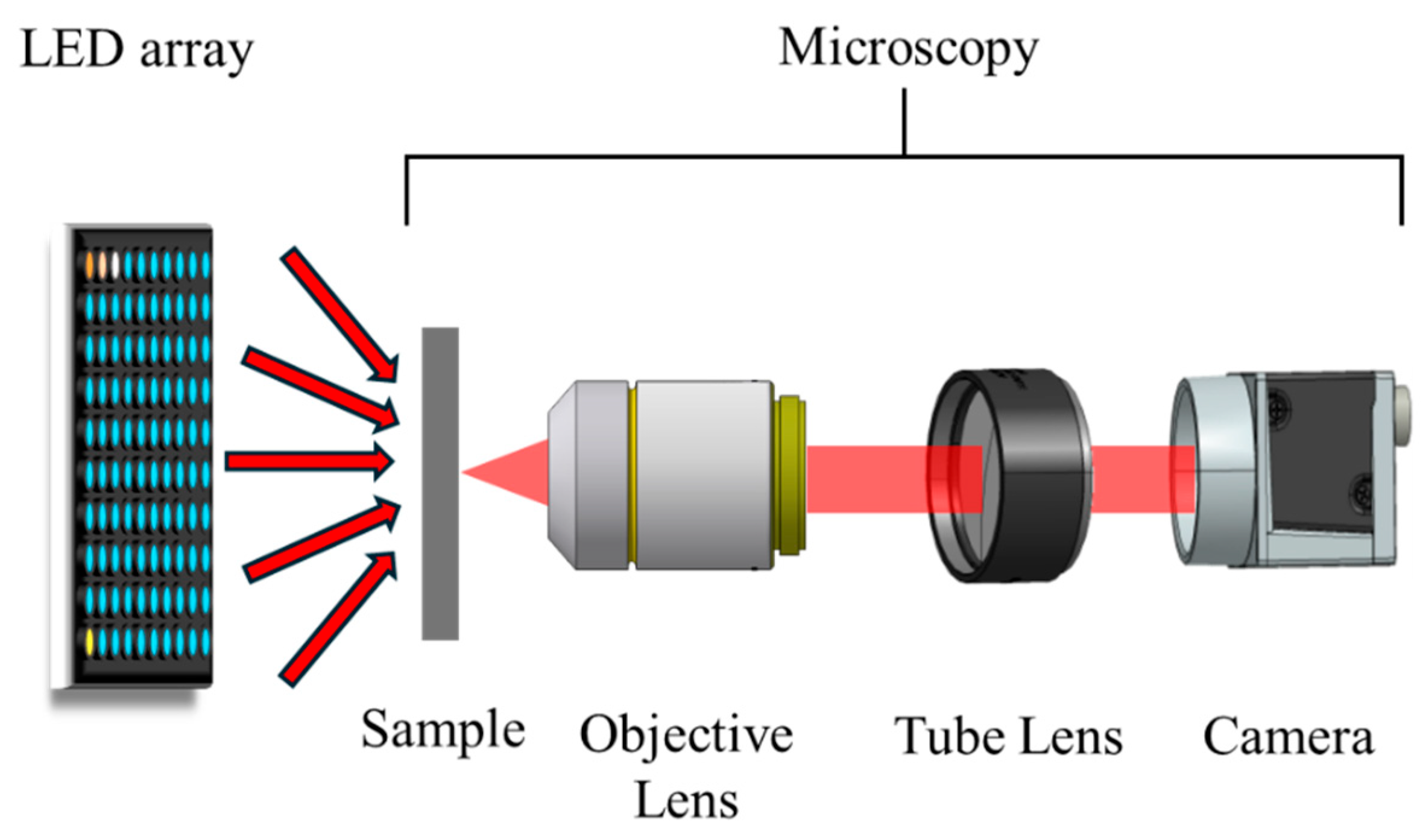
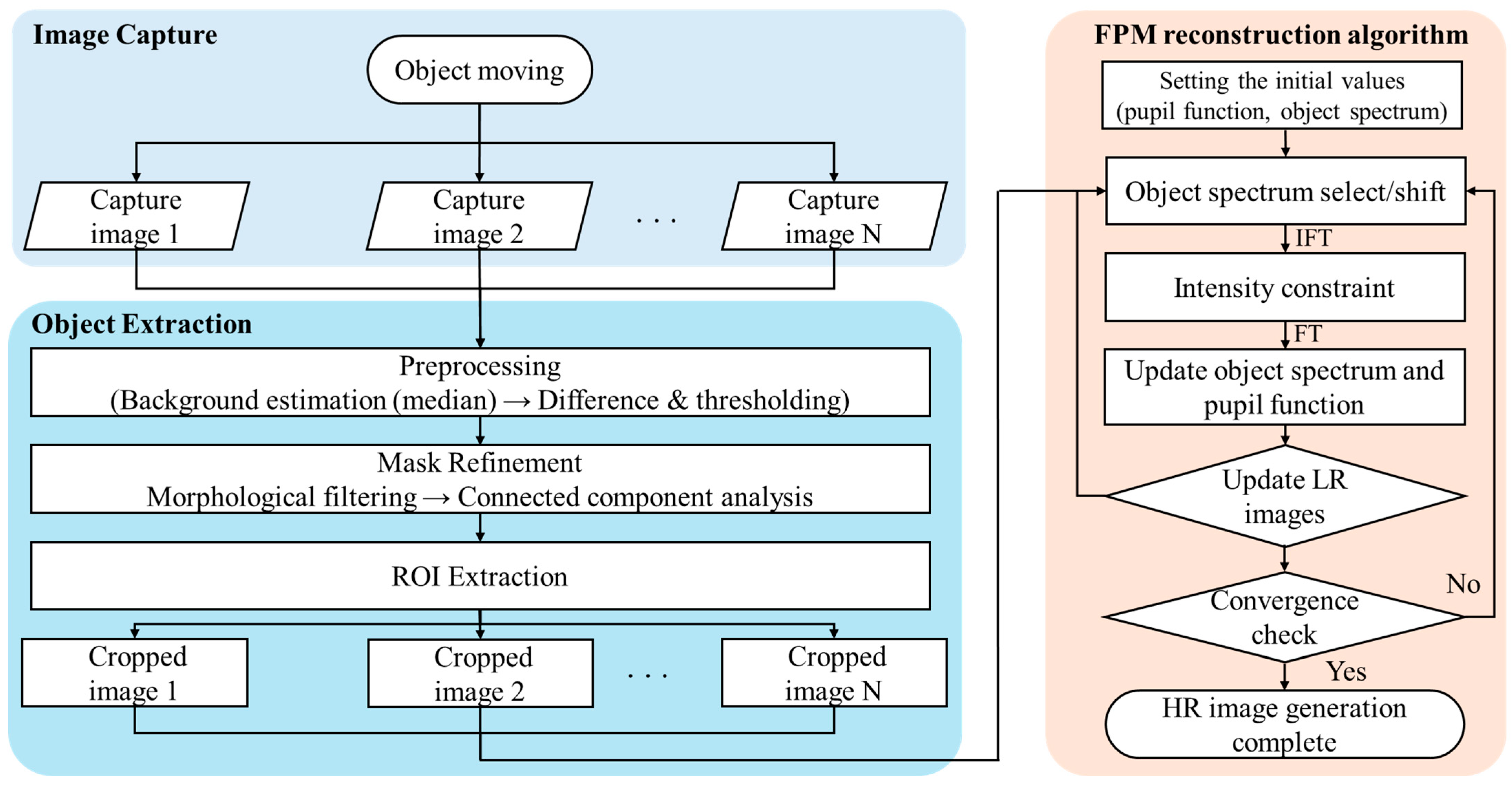
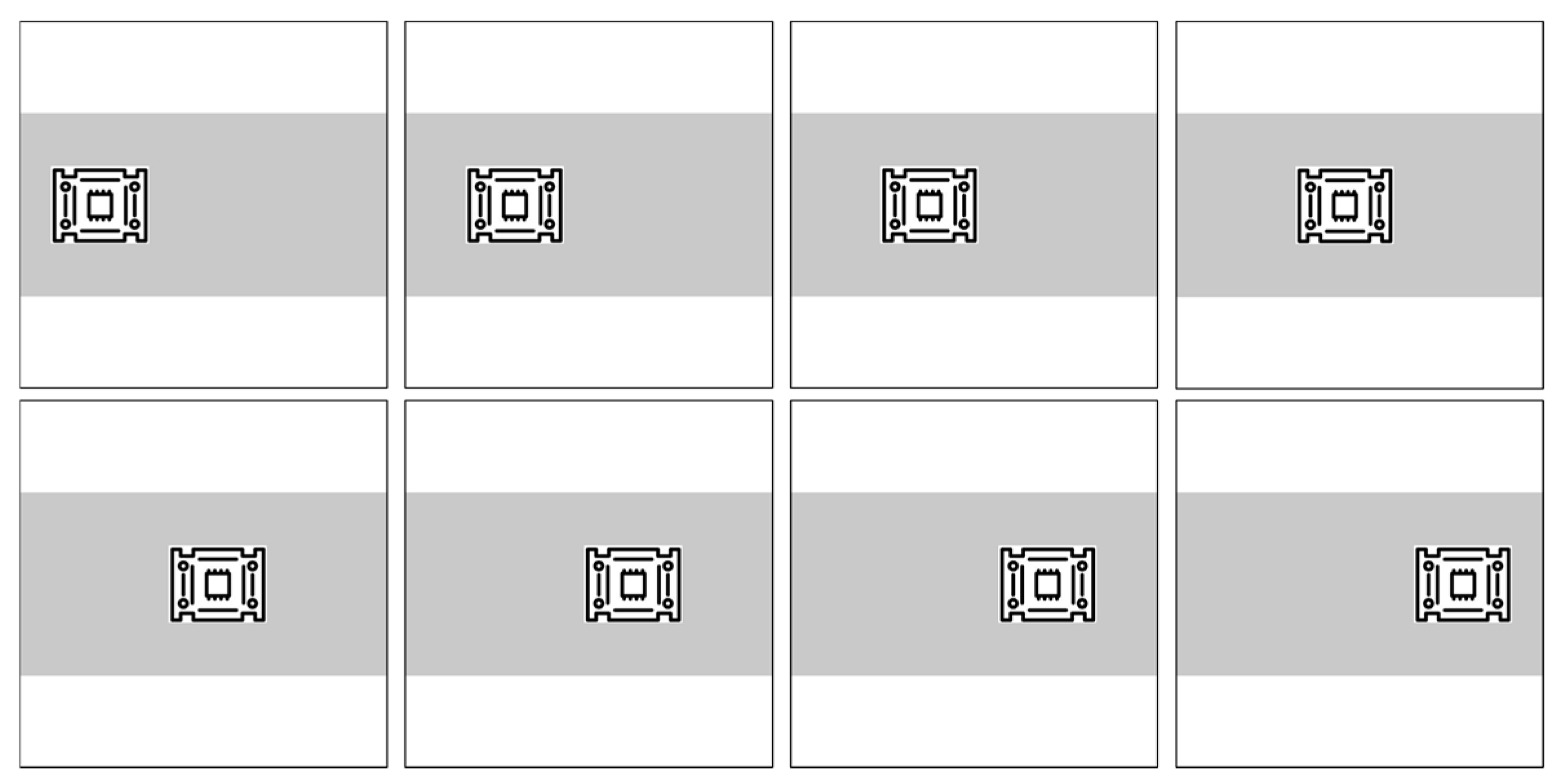


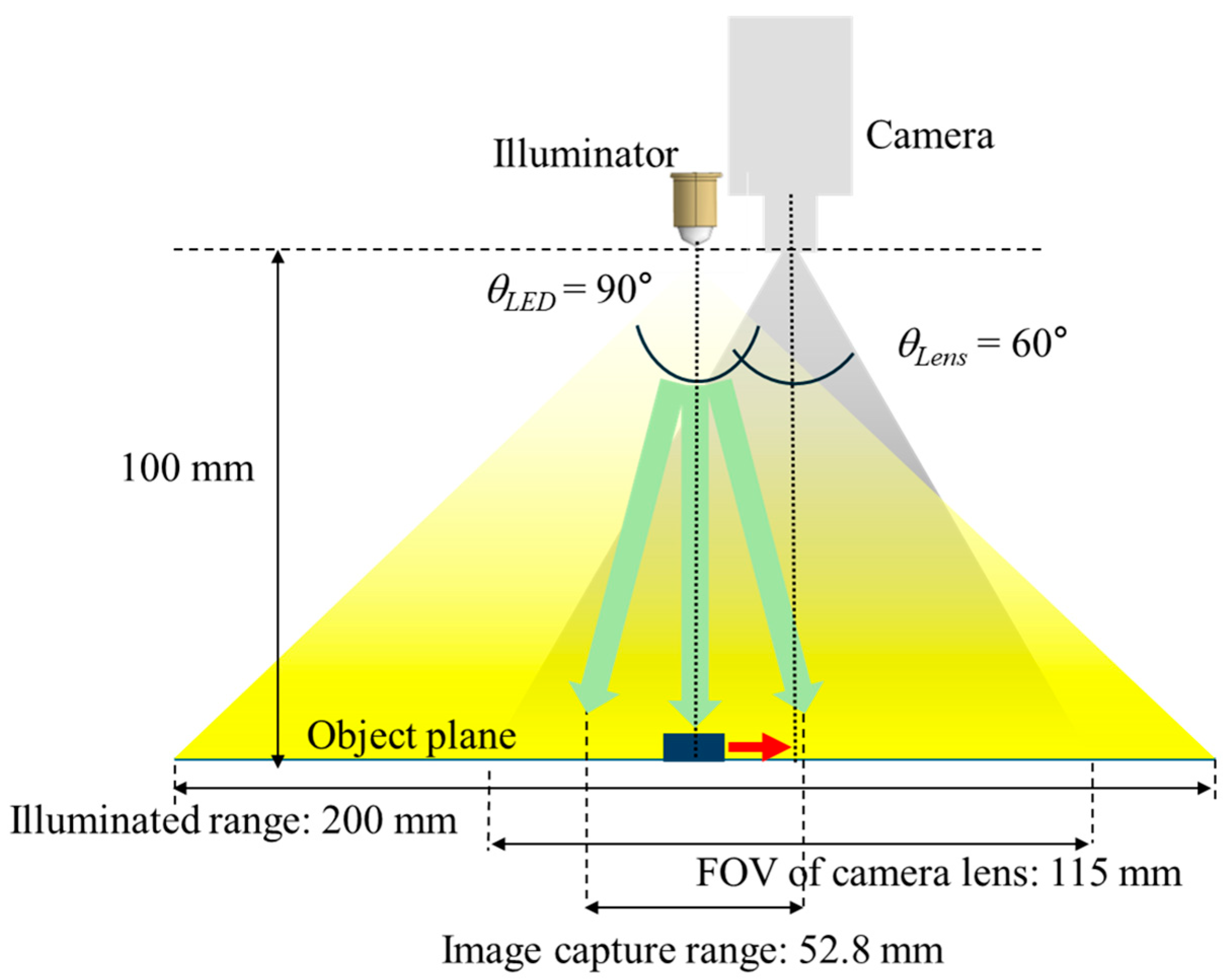
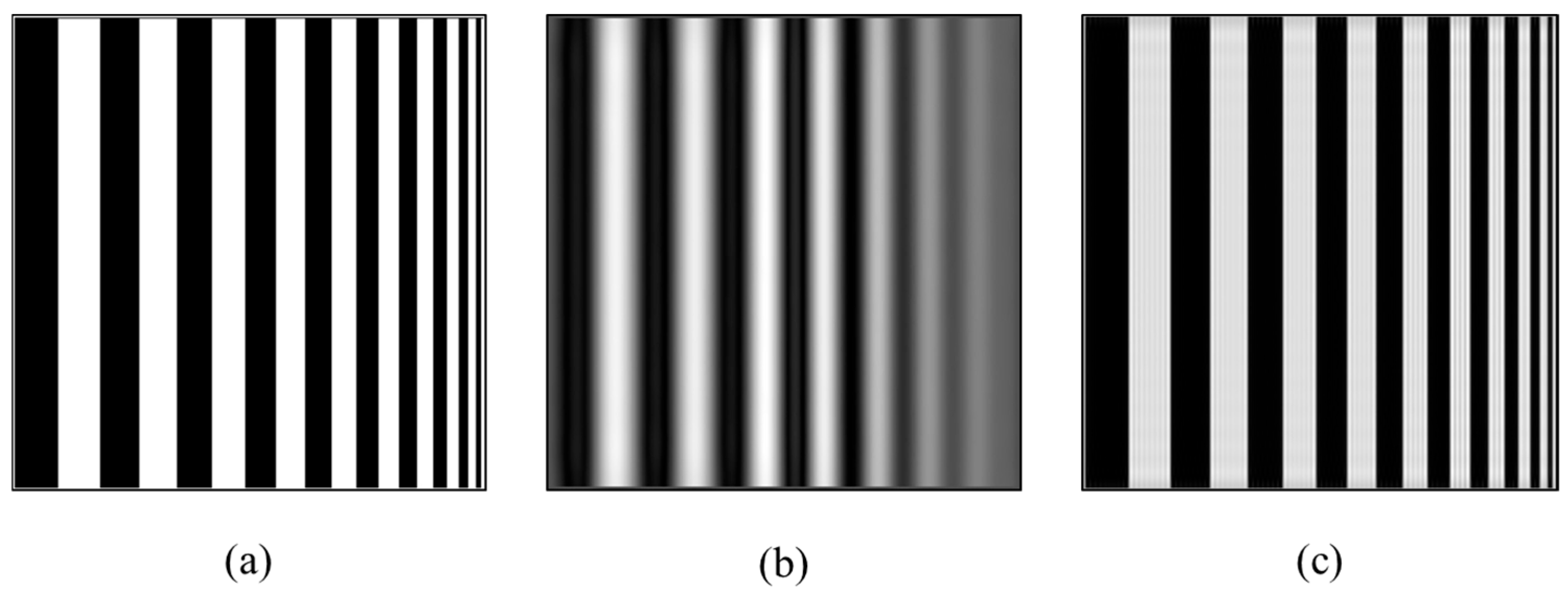
| Parameter | Value |
|---|---|
| Sensor size | 7.78 mm × 7.78 mm (2/3 inch) |
| Resolution | 2840 pixels × 2840 pixels |
| Pixel size | 2.74 μm × 2.74 μm |
| Parameter | Value |
|---|---|
| F-number | 8 |
| Working distance | 100 mm |
| Field of view | 60° |
| Magnification | 0.0677 |
Disclaimer/Publisher’s Note: The statements, opinions and data contained in all publications are solely those of the individual author(s) and contributor(s) and not of MDPI and/or the editor(s). MDPI and/or the editor(s) disclaim responsibility for any injury to people or property resulting from any ideas, methods, instructions or products referred to in the content. |
© 2025 by the authors. Licensee MDPI, Basel, Switzerland. This article is an open access article distributed under the terms and conditions of the Creative Commons Attribution (CC BY) license (https://creativecommons.org/licenses/by/4.0/).
Share and Cite
Oh, G.; Ha, J.; Choi, H. A High-Resolution Machine Vision System Using Computational Imaging Based on Multiple Image Capture During Object Transport. Photonics 2025, 12, 1104. https://doi.org/10.3390/photonics12111104
Oh G, Ha J, Choi H. A High-Resolution Machine Vision System Using Computational Imaging Based on Multiple Image Capture During Object Transport. Photonics. 2025; 12(11):1104. https://doi.org/10.3390/photonics12111104
Chicago/Turabian StyleOh, Giseok, Jeonghong Ha, and Hyun Choi. 2025. "A High-Resolution Machine Vision System Using Computational Imaging Based on Multiple Image Capture During Object Transport" Photonics 12, no. 11: 1104. https://doi.org/10.3390/photonics12111104
APA StyleOh, G., Ha, J., & Choi, H. (2025). A High-Resolution Machine Vision System Using Computational Imaging Based on Multiple Image Capture During Object Transport. Photonics, 12(11), 1104. https://doi.org/10.3390/photonics12111104





